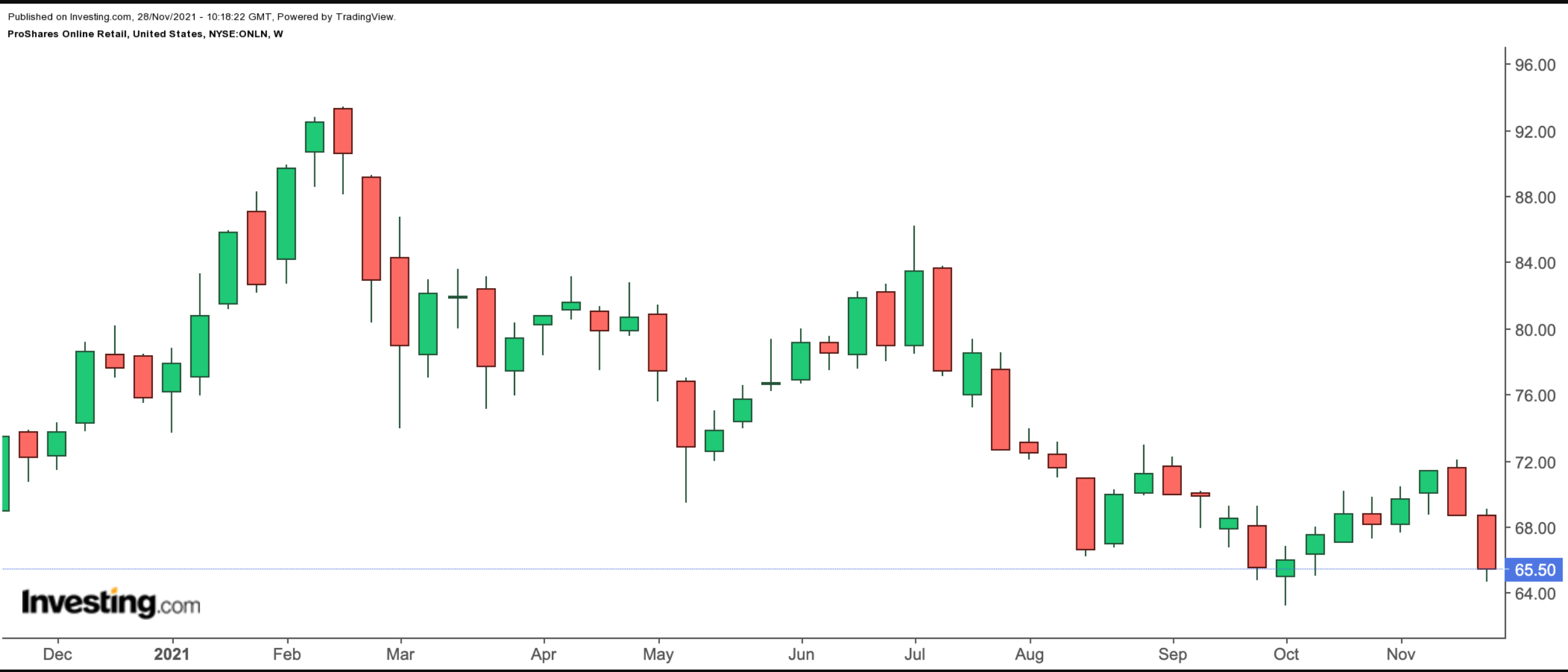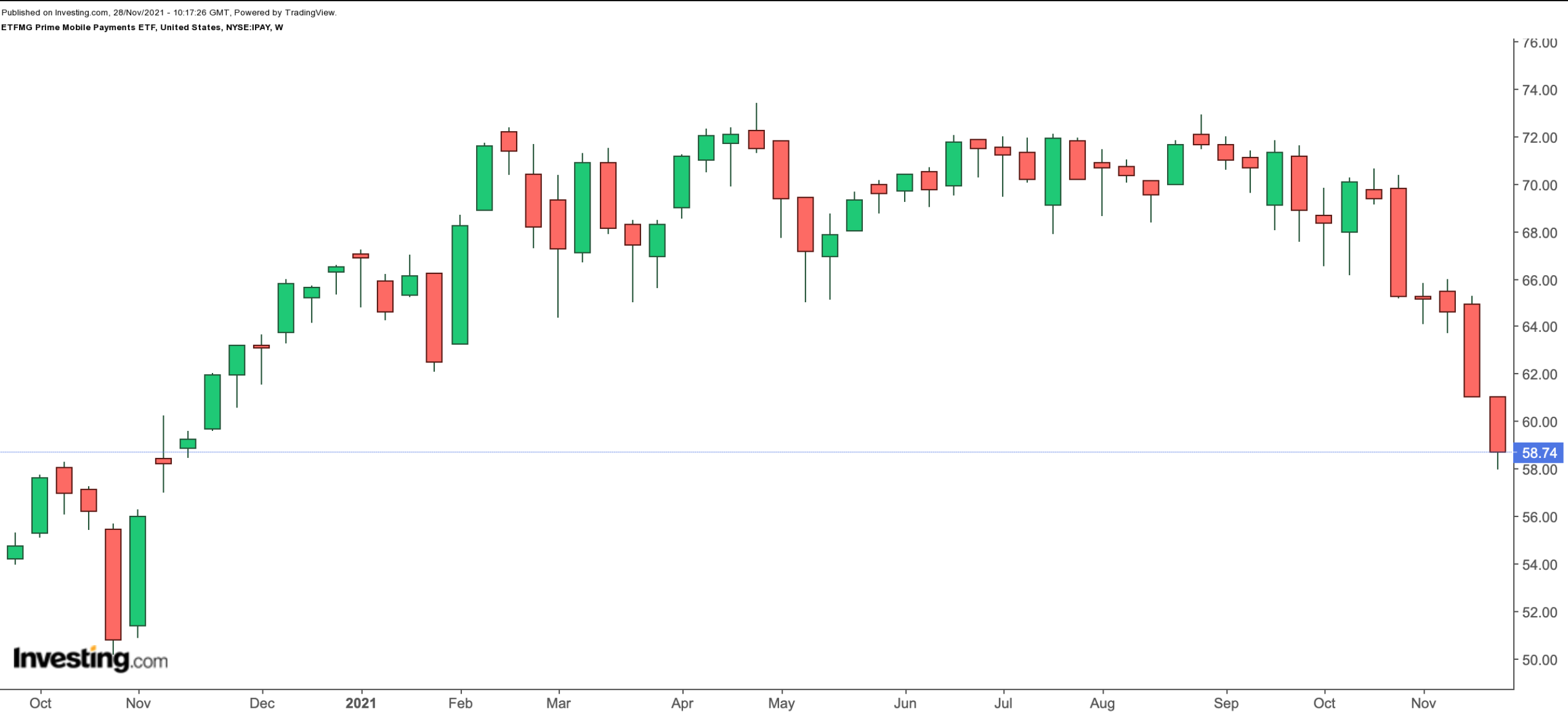Today is Cyber Monday, a day when online retailers stateside and increasingly worldwide offer significant discounts to shoppers. Last year, US sales revenue was close to $11 billion on Cyber Monday.
Statistics from Adobe highlight that over 41% of individuals used their mobile devices (as opposed to desktop) when they shopped.
As the new Omicron variant of the coronavirus dominates news headlines, a significant number of people are likely to shop online rather than visit crowded bricks-and-mortar stores. And metrics suggest that US shoppers are most interested in deals from names like Amazon (NASDAQ:AMZN), Target (NYSE:TGT), Walmart (NYSE:WMT), Best Buy (NYSE:BBY) and Kohls (NYSE:KSS), among others.
Therefore, today’s article introduces two thematic exchange-traded funds (ETFs) that could benefit from increased digital sales. Online shopping raises the specter of cyber crime so investors may also consider cybersecurity ETFs.
ProShares Online Retail ETF
- Current Price: $65.50
- 52 Week Range: $63.21 - $93.45
- Expense Ratio: 0.58% per year
The share of e-commerce as a percentage of overall retail sales has been increasing steadily over the past decade, and is now over 13%. Our first fund, the ProShares Online Retail (NYSE:ONLN), invests in 40 companies that mainly sell merchandise online. The fund was first listed in July 2018 and has close to $834.2 million under management.

Around three-quarters of the companies in the fund come from the US. Then China, Taiwan, Mexico and Argentina, among others. Close to 70% of the fund is in the top 10 stocks. In other words, it is top heavy. In fact, the top three names make up 40% of the fund.
Amazon has the highest slice with 26.06%, followed by the Chinese e-commerce giant Alibaba (NYSE:BABA), which came under significant regulatory pressure in 2021. Next in line are eBay (NASDAQ:EBAY), Singapore-based Sea (NYSE:SE), logistics platform DoorDash (NYSE:DASH) and Overstock.com (NASDAQ:OSTK), which has been steadily increasing its crypto exposure in recent years.
So far in 2021, ONLN is down 13.6%. After seeing a record high in February, the ETF lost around 30% of its value.
In recent months, investors rotated from shares that benefited from the 'stay-at-home, work-from-home' trend of 2020 into the post-COVID-19 era stocks. As a result, the fund has come under pressure. However, as many countries reintroduce measures against the Omicron variant, ONLN might easily catch investors’ attention once again. Interested readers could consider buying the ETF between $62-$65.
Meanwhile, investors looking for an equal-weighted fund that invests in a range of US-based retailers might consider researching the SPDR® S&P Retail ETF (NYSE:XRT).
2. ETFMG Prime Mobile Payments ETF
- Current Price: $58.74
- 52-week Range: $57.95 - $73.38
- Expense Ratio: 0.75% per year
Increasing global e-commerce sales volumes have brought attention to companies that focus on non-cash transactions and mobile payments. Recent metrics suggest that the global mobile payments market, which was valued close to $1.5 trillion in 2020, should reach $5.4 trillion in 2026. Such an increase in revenue would mean a compound annual growth rate (CAGR) of about 24.5%.
Today’s second fund, the ETFMG Prime Mobile Payments ETF (NYSE:IPAY), gives exposure to businesses in the electronic and mobile payments industry. They include credit card networks, payment processors, as well as those that provide software, payment infrastructure, and payment solutions like prepaid cards, smartcards or virtual wallets. The fund started trading in July 2015.

IPAY, which has 52 holdings, tracks the Prime Mobile Payments Index. The top 10 names make up about 55% of net assets of slightly over $1 billion. In terms of sub-sectors, we see Data Processing & Outsourced Services (84.32%), Consumer Finance (11.32%), Application Software (2.62%) and Electronic Equipment & Instruments (1.13%).
Leading holdings on the roster include the integrated payments group American Express (NYSE:AXP); financial services and payments technology heavyweights Mastercard (NYSE:MA) and Visa (NYSE:V); financial technology (fintech) group Square (NYSE:SQ), known for its digital payments ecosystem; and the Netherlands-based Adyen (OTC:ADYEY), which provides mobile and point-of-sale (POS) payment solutions.
Year-to-date, IPAY is down 11.7%. Since hitting an all-time high (ATH) at the end of April, the ETF has lost about 20% of its value. Potential buy-and-hold investors could regard the $55 level as a better entry point.
